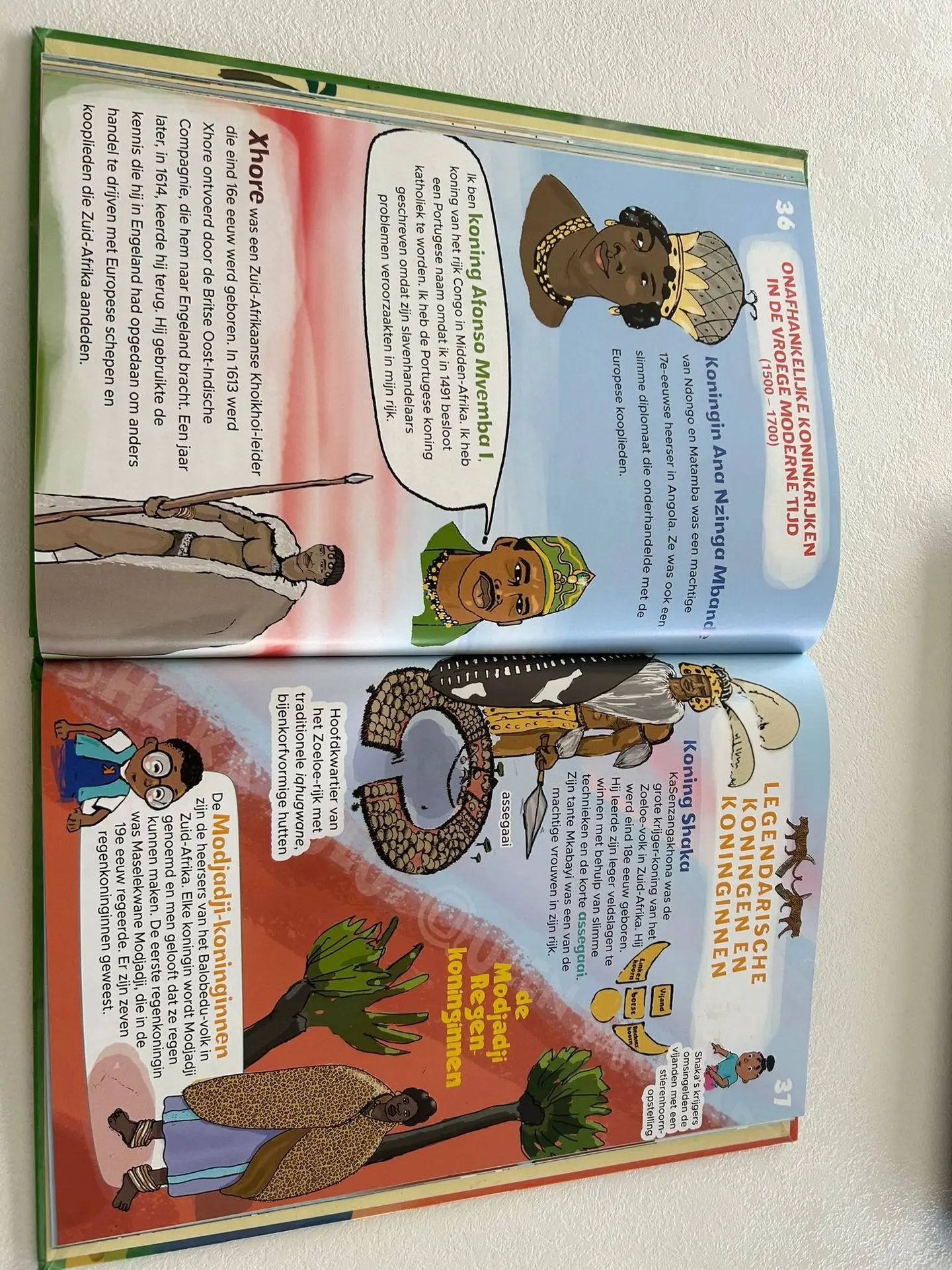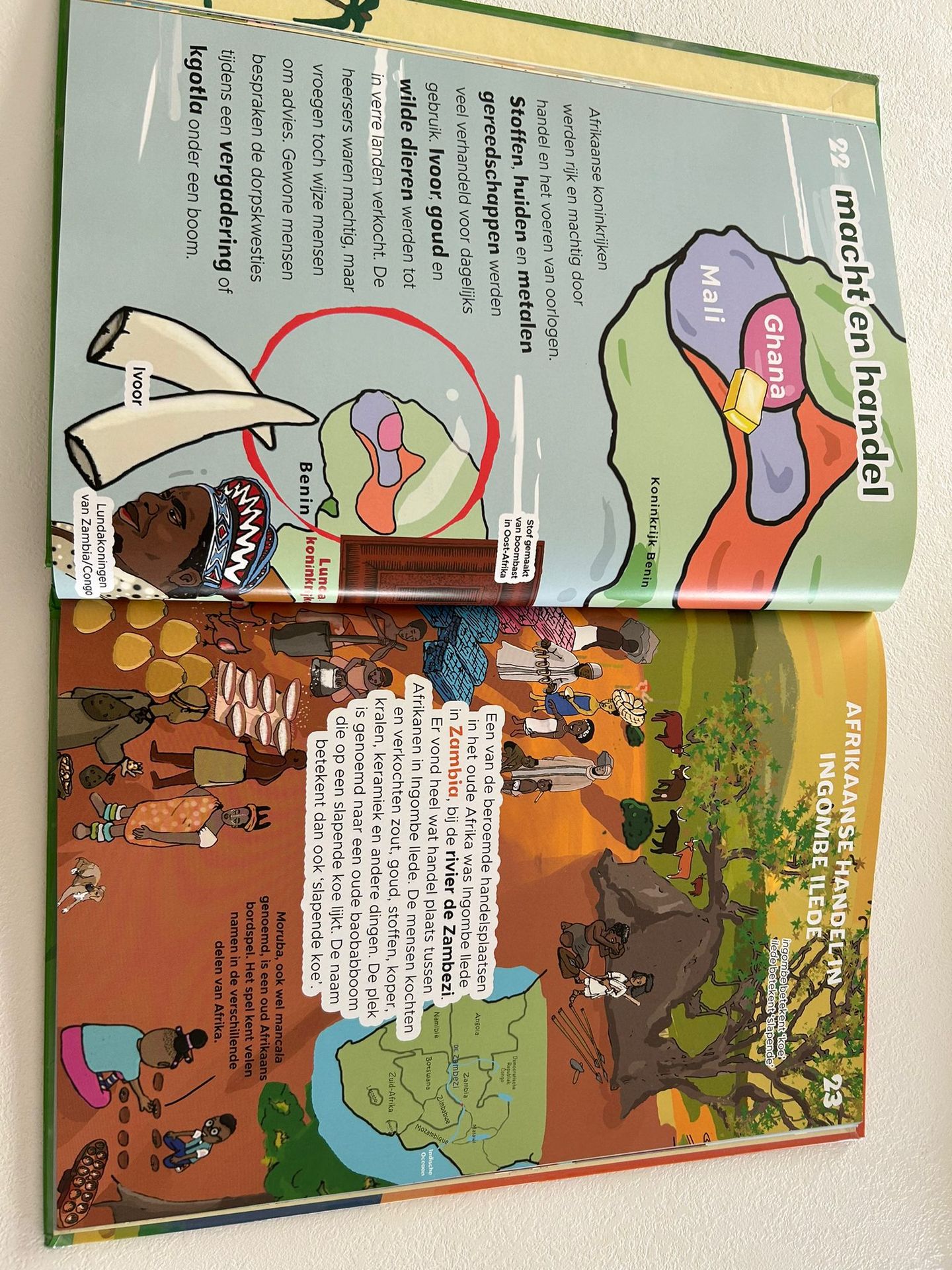Title:
In Africa with Avi and Kumbi
Author:
Khize wamaZambezi
Illustrations:
Sanelisiwe Singaphi en Bulelani Booi
Publisher:
Van Holkema & Warendorf
EAN:
9789000356713
About Khize Wamazambezi
There is limited information available about Khize Wama Zambezi.
It appears that the author is mainly known for the children's book In Africa with Avi and Kumbi. This book was written to introduce young readers to the rich history of Africa in a way that is both educational and accessible. It emphasizes the importance of an African perspective on the continent’s history, blending traditional stories and historical facts to raise awareness among children and adults about Africa's deep-rooted culture and often underrepresented stories. The book's focus on African history and culture implies that Zambezi has a passion for sharing stories that present the continent's rich history from an authentic, non-colonial perspective.
The motivation behind writing In Africa with Avi and Kumbi likely stems from a desire to provide children with an alternative to the Western narrative of history. The book seeks to promote African pride, identity, and education, and is intended to inspire children to feel connected to the heritage and history of the continent.
There is currently little detailed information available about Khize Wama Zambezi beyond the work In Africa with Avi and Kumbi. The name suggests a strong connection to African culture, possibly originating from Southern Africa given the name "Zambezi," which refers to the Zambezi River in that region.
The work he/she has created points to a deep desire to celebrate and pass on the identity and heritage of Africa to younger generations. The goal seems to be to bridge the gap in historical understanding and provide African children with role models and stories they can identify with.
Given that Zambezi's public profile is limited, it is possible that he/she is at the beginning of a writing career or chooses to remain in the background, focused on the work and the message conveyed through the stories.
1. Key points everyone should know
In Africa with Avi and Kumbi is a beautifully illustrated children's book that gives a historical overview of important moments in African history. It is an educational work meant to make young readers, as well as adults, aware of Africa's rich heritage and its impact on the world.
The key points that are essential to understand and remember are:
African civilizations before colonization: The story highlights that long before European colonizers arrived, Africa was a thriving continent with diverse cultures, kingdoms, and economies. Kingdoms like Ancient Egypt, Mali, and Great Zimbabwe are explained in detail.
The arrival of colonialism: Colonialism is presented not only as a geopolitical event but also as a huge disruption to African societies. Avi and Kumbi explain how this led to the exploitation of both people and natural resources.
Independence struggle: The story places great emphasis on African independence movements, focusing on the heroes of that time, like Thomas Sankara, Mwalimu Julius Nyerere, Mbuya Nehanda, and others who fought for freedom and self-determination.
2. Summary of the story
The story starts with the main characters, Avi and Kumbi, two young children who travel through time to witness important moments in African history. Their journey begins in Africa 200,000 years ago, where they explain archaeological and oral traditions. It starts with cave art and a brief explanation of Homo sapiens. They describe, using pictures and words, how early humans in Africa lived, with a detailed look of what they did for a living: fishing, hunting, and farming.
The second part of the story begins with ancient Egypt, where they learn about the mighty pharaohs and the impressive achievements of the Egyptians architecture and science. Did you know that Queen Cleopatra was the last Greek ruler of ancient Egypt? The history of Nubia is also a passage in the book, with emperor Caesar. Alexandria is highlighted through various stories, including the lighthouse of Alexandria. From there, they travel to West Africa to explore the glory days of the Mali Empire, including the story of Mansa Musa, one of the richest people ever, who used his wealth to promote cultural exchange and knowledge.
During these travels, Avi and Kumbi share details about what Africa represented and its global contributions. They discuss Egypt's famous architecture, but also lesser-known facts, like how Africans made fabrics from bark. They had different types of looms and dyed fabrics in various colors to trade overseas. Metal came from African lands and rocks. Africans discovered how to heat metal from rocks to create tools, weapons, and sculptures. That wasn’t all—ivory, gold (a lot of gold), wild animals, gas, platinum, and cobalt also came from Africa.
Avi and Kumbi's journey takes a dramatic turn when they witness the arrival of European traders and explorers. They discover Africa's immense value, and Europeans want more and more of the African land. Many (like Julius Caesar, Alexander the Great, and Prince Henry the navigator) attempted to control it. The book briefly explains what happened at that time over a full page.
Later, Avi and Kumbi witness the colonization of Africa. The impact of slavery and the exploitation of African peoples by European powers is told in an accessible yet powerful way. Avi and Kumbi visit various parts of Africa during the colonial period, learning about life under British and French colonial rule, as well as under Belgium’s King Leopold II.
A major part of the story is the fight for independence in the 20th century. Readers meet figures like Thomas Sankara (the revolutionary leader of Burkina Faso who fought for economic independence and anti-imperialism), Mwalimu Julius Nyerere (the first president of Tanzania and champion of pan-African ideals), and Mbuya Nehanda (a spiritual leader and symbol of resistance against British rule in Zimbabwe). The book ends by celebrating African independence and the resilience of the people, while also reminding us that the effects of colonialism are still felt today.
3. Connecting to our world
The themes in In Africa with Avi and Kumbi have clear parallels to our modern society. Here are some important connections between the story and the world today:
The book connects with today’s global efforts to rewrite history and provide a more holistic view of the past. In many countries, there is a struggle to remove Eurocentric perspectives from school curricula and focus more on non-Western stories. This is similar to what is presented in the story: a reevaluation of African history and culture as important and central to world history.
The stories of Sankara, Nyerere, and Nehanda still resonate today, especially in light of current movements for equality and self-determination. The fight for economic independence and against imperialism, like that of Thomas Sankara, can be seen as an early form of today’s global fight against inequality and exploitation by international economic systems. Today, we work towards inclusion.
4. Two Possible connections to your own experiences or world events
Avi and Kumbi learn about different cultures, languages, and kingdoms within Africa. This can be compared to Belgium's diverse society, where multiple languages and cultures exist side by side (Flemish, Walloon, Deutch and various migrant groups). Just as the book emphasizes understanding different backgrounds, Belgium also focuses on the need for inclusion and respect for diversity, for example, through integration programs for migrants and educational initiatives that promote cultural diversity.
The book discusses colonialism and its effects on African societies. A clear connection to Belgium is the country’s colonial history, particularly in Congo (now the Democratic Republic of Congo). King Leopold II personally owned Congo, and Belgian colonization had a huge impact on both Congo and Belgium. This history is increasingly discussed in Belgium, especially regarding the role of the colonial past in today’s debates on racism and inequality.
You can also discover Africa's rich history in the book, which is similar to the importance of history lessons in Belgium. Just as the book raises awareness of young readers about their heritage, Belgian schools teach about important themes like the two World Wars, the founding of the Belgian state, and the recent focus on decolonization in education. The growing emphasis on a more inclusive history curriculum ensures that the colonial past and contributions from different communities are discussed, similar to Avi and Kumbi’s journey of discovery.
5. Can I ask you a question?
How do you think the stories of African independence fighters, like Thomas Sankara or Mbuya Nehanda, can inspire us today? What can we learn from their approach to freedom and equality?
Do you think Belgium should take more action regarding its colonial history?
6. Ask to make connections to their own context
Which historical figures from your own culture fought a similar struggle for independence or justice?
7. Similarities and differences
One theme in the book is the respect for elders and ancestors, which is a key part of daily life in many African cultures but often less central in Western societies. In Western cultures, we often respect the (grand)parents we knew, but those we didn't knew are often forgotten or rarely spoken about.
In many African cultures, as described in the book, the relationship with nature often has spiritual significance. Nature is seen not only as a source of life but also as something sacred, with rivers, mountains, and forests often considered holy. In Belgium, this sacred aspect of nature is less prominent, and the relationship with nature is more functional or recreational.
In many African cultures, families are often larger and more community-focused, with grandparents, aunts, uncles, and cousins all involved in raising children. In Belgium, the nuclear family (parents and children) is usually the main family structure, and extended family members play a less active role in daily family life.
In African cultures, like in In Africa with Avi and Kumbi, oral history plays a much bigger role and remains an important way of passing down knowledge, values, and traditions. The book shows how storytellers and oral traditions are valued as the keepers of culture. In Belgium, written records have mostly replaced these oral traditions, especially since literacy and printing became widespread.
8. Specific cultural passages
Passage 1:
The encounter of Avi and Kumbi with the Queen of Sheba in the chapter on the ancient kingdoms is a beautiful moment that sheds light on the role of women in leadership in precolonial Africa. In this passage, readers learn about the Queen of Sheba (also known as Makeda). She is often praised for her wisdom, wealth, and diplomatic skills, and her reign over a kingdom in Africa makes her one of the early examples of female leaders in world history.
I want to compare the Queen of Sheba to the role of women in positions of power in other parts of the world: In precolonial Africa, women like the Queen of Sheba were more inclined to hold leadership roles that involved not only political but also spiritual and social authority. They were seen as natural leaders, and in many cases, there was no separation between male and female domains of power.
In many parts of Europe, women had less direct access to political power. Often they had to exercise power through their male family members (husbands, sons, or brothers). Even when they ascended the throne, such as Queen Elizabeth of England, their rule was often limited by strict gender norms and expectations. Nowadays, we see more and more women in politics and in positions of power. A connection to this in Belgium is the role of women in politics, such as Sophie Wilmès, the first female prime minister of Belgium. Just like the Queen of Sheba was a leader in her time, Wilmès represents modern women entering positions of power, which is an important step in breaking gender barriers in leadership.
Passage 2:
In the chapter on the colonization of Zimbabwe, it is described how Mbuya Nehanda, as a spiritual leader, was executed by the British due to her resistance. This is a powerful moment that shows how colonial powers tried to suppress spiritual leaders to establish their control.
9. Question to the group about culture:
How important is the connection to ancestors and traditions in your culture?
How does this relate to what Avi and Kumbi show about African ancestor worship?
Let me know what you think!
Feedback groupassignment:
The book is very interesting for understanding the full culture of the continent. However, it does not seem to be at a child-friendly level. The teacher would need to translate it entirely to make it clear for the children.
A second point is that we need to critically examine this book. Does it include all relevant information? Is it discussed from both perspectives? Is everything accurate?
History is educational and important for the future and our process of decolonization.


